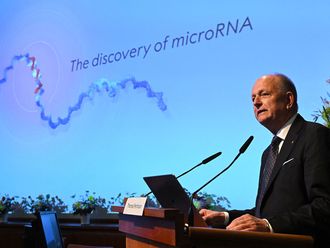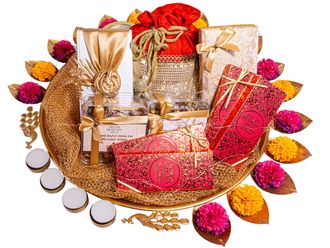Opening mind, body and spirit to alternative cures.
"The art of healing comes from nature, not from the physician.
Therefore, the physician must start from nature, with an open mind."
— Swiss physician, alchemist and scientist Philippus Aureolus Paracelsus
Sometimes an open mind is the difference between prescribing an antihistamine pill to suppress a cold or suggesting a herbal infusion to clear it, recommending a pain killer for back pain or advising reflexology to relieve it.
However, while a majority of the conventional medical community are still debating these issues, there are a growing number of doctors who are drawing from complementary and alternative therapies (CAM) to improve the efficacy of their treatments.
A good example of this is Dr Mehmet Oz, one of the world's most respected cardiac surgeons. He uses yoga, aromatherapy, hypnosis, energy healing, music therapy and acupuncture in combination with cardiac care. Then there's the pioneer in the area of mind-body medicine, Deepak Chopra, whose education in conventional medicine has not interfered with his faith in ancient healing traditions such as Ayurveda. Dr Andrew Weil, a best-selling author and physician, is another example of prominent conventional medical practitioners using integrative medicine to treat and heal patients.
Two approaches
In Dubai, Dr Ludmila Vassileva, a certified medical doctor specialising in homoeopathy, also adopts an integrative approach to healing. She runs the Holistic Healing Medical Center, where conventional medical services are offered in conjunction with homoeopathy, iridology, acupuncture and yoga therapy.
Dr Vassileva says that it's beneficial to combine the science behind conventional medicine with the wisdom of traditional medicine. "Conventional medicine is based on suppressing symptoms that the body manifests when there is a disturbance in the balance of the energies regulating our body, which we refer to as 'negative' and 'positive' or 'yin' and 'yang' (as in traditional Chinese medicine). The body has a built-in mechanism to deal with such imbalances. However, when the body can't restore balance or wants to eliminate toxins affecting the body, it expresses these conditions through symptoms such as inflammation, fever, vomiting or diarrhoea.
"While conventional medicines such as anti-inflammatory drugs suppress these symptoms, traditional medicines such as homoeopathy, works toward helping these symptoms bring about productive results, and restore balance. They also work on strengthening the body's self-healing abilities. However, one cannot ignore the fact that conventional medicine is important, especially for serious conditions that need immediate medical help."
An interesting element in the integrated approach that Dr Vassileva adopts is the use of a telemetric non-linear diagnostic tool called the NLS Oberon to get a detailed analysis on biochemicals, pathologies, micro organisms, parasites and allergens present in the body. The system, which was designed by Russian scientists, also evaluates the body's condition by recording changes in the frequency at the cellular level of organs and other parts of the body. It can record frequencies below infrared. It can also detect the frequencies of chemical, homeopathic and herbal medicine, and neutraceuticals, and evaluate whether or not they harmonise with the body.
According to Saya Pareeth, a homoeopath at the Holistic Healing Medical Center, the diagnostic system, which evaluates the condition of the body as a whole system, relies on a huge database of references, which can help the system diagnose the frequency of a healthy body and one with a disease. The analysis provided by this system is then used to arrive at a treatment programme, which could include general medicine, homoeopathy or even acupuncture.
Like the Holistic Healing Medical Center, the Rochester Wellness clinic also treats patients using a holistic approach. Daffodils Guevarra, MD, the in-house physiatrist at the clinic, says that doctors are now realising that it is more important to treat the person as a whole, and not just the person's disease.
"Holistic therapies aim to help the patient restore the balance, thus allowing the body to heal itself naturally. However, for a physician who has dedicated 10 years of his life studying medicine, this concept can be quite unnerving. But more doctors are now starting to accept this view, and combine science and technology and a holistic approach to manage disease," she says.
Guevarra emphasises that some diseases also have multiple causes, and the best approach to these conditions is to manage them as multi-factorial cases. So treating the patient as a whole and not just the patient's condition itself has been an effective approach so far.
"For instance, people with back pain tend to heal faster if I tell them to go for an acupuncture session, get physiotherapy, have their pain medication (when needed), practice and heed medical advice related to proper positions, ergonomics and exercise, maintain a healthy lifestyle and keep stress away through various means, including massages, yoga and long walks," she says.
People today are also more open to trying out new therapies, especially ones such as acupuncture, ayurveda and reiki, which are minimally or non-invasive at all, says Guevarra.
"Science is often misinterpreted as cold and impersonal; and can disappoint our huge aspirations. Thus individualised, empathetic care offered by alternative therapies practitioners has a market, particularly if it claims to help where science has failed. Besides, a lot of people are frustrated with the care that they're given from traditional medicine, not so much the treatment, but the limited time that doctors offer them. Complementary therapies offer a lot of care and support to the patient. Hence, people are turning to alternative medicine," says Mala Jham, a Dubai-based therapist, who uses reiki, craniosacral therapy, Brennan healing science, crystal therapy and jin shin jyutsu to treat patients.
Lamia Saldanha, a Dubai-based professional who works with Nakheel, a leading property developer, is one of the many who now relies on alternative therapies to deal with health problems. "I have been given reiki energy healing for migranes, muscle injuries, tooth pain, emotional healing, and to calm an 'irritated' intestine. This has worked in either solving the problem or momentarily healing the area in pain. The additional benefits include stress reduction and relaxation. I also swear by acupuncture and cupping therapy, especially since it works wonders for problems such as a stiff neck or backache. I have actually dozed off during some of my treatments and felt much better in just one session."
Stephanie Santana, a PR professional, says, "I have found that reiki and Brennan Healing have had a huge impact in my life. I was fortunate enough to find two skilled CAM therapists who helped me through some of the most difficult times of my life. One helped me with an unidentified stomach problem I had had since I was a child, something that conventional medicine and doctors had been unable to ease. This particular healer was able to remove the pain and discomfort I had for over 15 years in two sessions. The second healer is Dubai-based Cathy Darnell. She helped me with many things but what I am most thankful for is her ability to have removed physical pain in my body due to previous emotional trauma."
Dr Sean Penny, a homoeopath at the Dubai Herbal and Treatment Centre, which also uses a holistic approach in the treatments they offer, says it is interesting to see how many of these therapies are now becoming first-line treatment options for patients and no longer 'last resorts'. "I expect that, in Dubai, these alternative therapies will become even more popular in a short space of time as people become more aware of their benefits," he says.
Jham also sees this trend growing. She says, "The future of healthcare needs to have a combined approach where both the doctors and alternative healing therapists work together to provide optimal health to the people." After all, it all boils down to having an open mind to new approaches to healing.
OPTIONS UNLIMITED
Here's a quick look at some of the alternative therapies to combat everything from back pain and digestive disorders to skin problems and stress.
Acupuncture is based on the premise that the body contains pathways of energy called 'meridians'. The smooth flow of energy through these conduits promotes good health, while blocks in the flow can cause an imbalance in the functioning of organs and processes such as digestion. Acupuncture uses very fine needles, placed on different points of the body to free the channels of blockages. Acupuncture is also said to be helpful in pain management.
Aromatherapy involves the use of essential oils (such as lavender, bergamot, tea tree) extracted from certain trees, shrubs, herbs, grasses, fruits and flowers, says Sunita Tekchand, a clinical aromatherapist. Tekchand, who has used these oils to treat several patients including those recommended by cardiologists, dentists and dermatologists, says that aromatherapy is great for stress, depression and skin problems.
"Ayurveda is based on the knowledge of 'prakriti' or an individual's constitution, which holds the key to an optimal diet and lifestyle suited for a person. There are three 'doshas' (body types) called 'vata', 'pitta', and 'kapha'. Each 'dosha' is present throughout our physiology, governing all activities of the whole body, mind and emotions. Ayurveda uses the understanding of these doshas to access deeper, more powerful levels of the body's healing intelligence to alleviate diseases," says Dr Asha Rani, a General Physician in ayurveda at the Dubai Herbal and treatment Center.
"Chiropractic works with the spinal column and the nervous system. Misalignments in the spine can affect the body's functions and put pressure on our nerves. We use manual adjustments or 'manipulation' to realign joints in the direction that they should be moving towards, especially since this allows the nervous system to function optimally.
This works for problems such as neck, back or joint pain, as well as sports injuries," says Dr Travis Mitchell, a chiropractor at the Dubai Health and treatment Center. Dr Mitchell also uses the technique to help balance conditions linked to the nervous system such as hyperactivity and underactivity.
"Homoeopathy is based on the principle of 'Like cures like'. In other words, substances in high or toxic doses cause a certain set of symptoms that in tiny doses can help cure illnesses that have those same symptoms," says Dr Sean Penny, a homoeopath with the Dubai Herbal and Treatment Centre. Penny says that the ailments effectively treated by homoeopathy are numerous, and include, infectious diseases, irritable bowel syndrome and other non-surgical digestive disorders, chronic fatigue, allergies and sports injuries.
"Kinesiology is a system of natural healthcare, which combines manual muscle testing with the principles of traditional Chinese medicine, energy balancing and other healing modalities. Kinesiology assessment uses muscle testing to let the body find the location and/or nature of its imbalances, and dictate its preference for treatment," says Brenda Ganwani, a 'Touch for Health' kinesiology therapist. Other popular complementary therapies that focus on balancing the body's 'life force' ('chi', 'qi' or 'prana') energy to promote healing. Some of these include reiki, pranic healing and jin shin jyutsu. Mala Jham, a therapist who uses reiki, cranio-sacral therapy, Brennan healing science, crystal therapy and jin shin jyutsu to treat patients, says jin shin jyutsu is a valuable complement to conventional healing methods.
Reflexology, says Birgit E Schurenberg, involves the stimulation of various pressure points in the hands and feet, which are linked to different organs, glands and nerves. "Reflexology can induce deep relaxation and reduce stress," says Schurenberg. It can also bring relief to different kinds of pain. Schurenberg also uses vertical reflex therapy to treat patients. This therapy is a shorter but very comprehensive and is beneficial for patients suffering from imbalances in the neck, shoulder and back.











